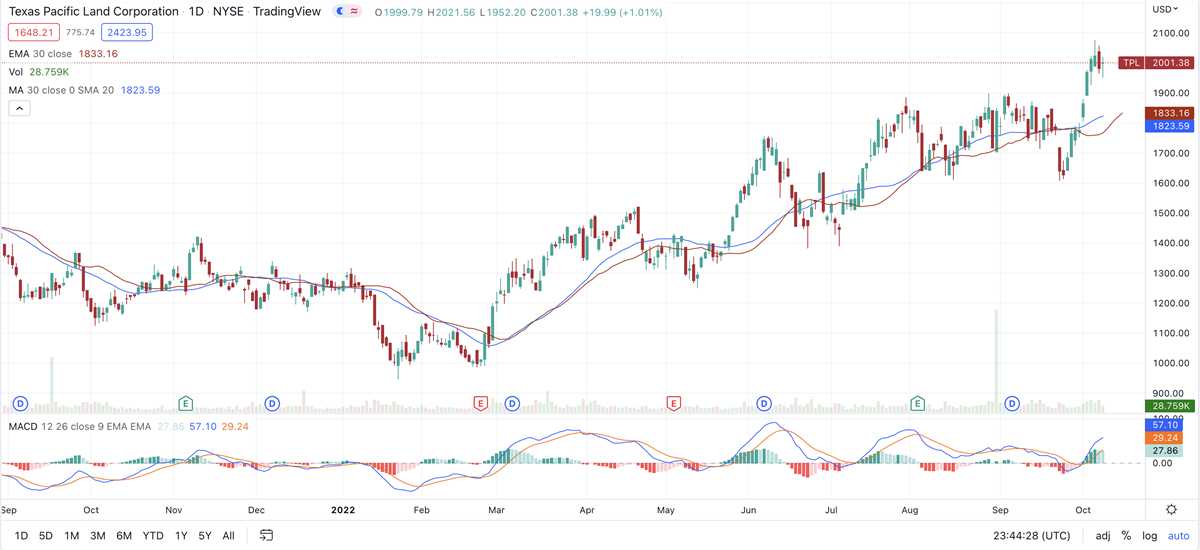 Energy, the lone soldier, stands as the only sector with a year-to-date gain. Texas Pacific Land Corporation (NYSE: TPL) leads in price in an industry that offers an alternative way to access oil and gas performance.
Energy, the lone soldier, stands as the only sector with a year-to-date gain. Texas Pacific Land Corporation (NYSE: TPL) leads in price in an industry that offers an alternative way to access oil and gas performance. Shares rose 11.49% the week ended October 7, outpacing the S&P 500 by a wide margin. The large-cap index was up 1.57%. The MSCI All Country World Index index is the best comparison, as TPL was added to that index in August. It’s tracked by ETFs including the iShares MSCI ACWI ETF (NASDAQ: ACWI).
On Monday, the ACWI index was down 0.80%, while TPL advanced 1.01%, ending the season at $2,001.38, a gain of $19.99.
Dallas-based Texas Pacific Land Corp. owns stakes in oil, gas and mineral production operations. It was formerly organized as a trust but shifted to a corporate structure in 2021. TPL also manages, leases and sells land and provides water-related services. It also recycles and treats water from oil and gas wells and provides water infrastructure development for the oil and gas industry. It operates in the Permian Basin in Texas.
The company offers an opportunity for recurring revenue through its business model but it's also dependent upon energy prices. Distributions fall as energy reserves become depleted. That means the company must continually develop new sources of income. The recurring revenue based on a cut of drilling income as well as land leasing can certainly smooth what could otherwise become a rollercoaster ride. 
In recent months, TPL’s fortunes have largely tracked those of the energy industry as a whole. Earnings grew between 77% and 109% in the past five quarters. Revenue increased between 66% and 98% during that time. For the foreseeable future, analysts expect that strong performance to continue. Wall Street has pegged earnings per share at $59 for the full year, a gain of 69%. Next year, it may rise another 12% to $65.83 per share.
Texas Pacific will report its third quarter on November 2, with analysts expecting earnings of $14.38 per share on revenue of $161.84 million. Those would mark year-over-year increases of 33% and 31%, respectively.
Despite having a market capitalization of $15.65 billion, TPL has sparse analyst coverage, which is sometimes true of companies from somewhat obscure industries. Lack of coverage can sometimes limit institutional ownership because many mutual funds, ETFs, banks, insurance companies and other large owners do not put the company on its radar.
However, TPL has seen more institutional buying than selling in the past 12 months — always a good sign. That corresponds with price performance over the following time frames:
- 1 month: +8.01%
- 3 month: +29.51%
- Year-to-date: +60.98%
The stock’s chart extends beyond its most recent area of price consolidation after passing a $1,899 buy point on October 4 and continues to rise. It’s now 5.4% above that buy point. You don’t want to chase a stock after a breakout, as it’s not unusual for it to pull back as some owners take profits before others step in to buy more shares at a somewhat lower valuation.
Other companies in the oil and gas royalty trust business also show better price performance than the broader market.
In addition to strong earnings and price growth, TPL has other positives, including low debt levels. The company does not invest capital in exploration and production, which sets it apart from more capital intensive oil and gas companies, such as Cheniere Energy (NYSE: LNG), which has gone through investment cycles to achieve the growth it has today.
Texas Pacific owns its oil rig land but doesn’t take the risk of building infrastructure. It does have the opportunity to get higher rents for top-producing properties as well as negotiate a cut from drillers that use its properties.
The company’s return on equity is very solid, at 35.
Other standouts from the oil and gas realty trust industry include BP Prudhoe Bay Royalty Trust (NYSE: BPT), Permian Basin Royalty Trust (NYSE: PBT) and Sabine Royalty Trust (NYSE: SBR).